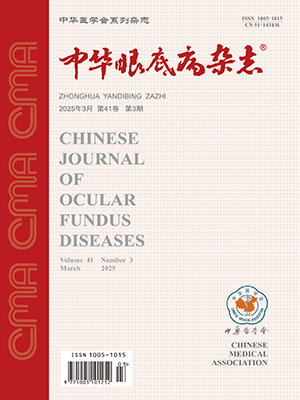Objective To investigate the risk factors associated with visual acuity after minimally invasive vitrectomy of idiopathic macular hole (IMH). Methods Forty-six IMH patients (50 eyes) who underwent minimally invasive vitrectomy were enrolled in this prospective clinical study. The patients included eight males (nine eyes) and 38 females (41 eyes), with a mean age of (60.7 plusmn;9.6) years. All the patients were examined for Snellen corrected visual acuity (CVA), optometry, slit lamp microscope and preset lens, as well as spectral domain optical coherence tomography (SD-OCT). The CVA was converted into a logarithm of the minimal angle of resolution (logMAR) for statistical analysis. The mean logMAR CVA was 0.95 plusmn;0.29 (CVA ranged from 0.02 - 0.6). The mean duration was (11.1 plusmn;7.8) months. The mean breaking length of inner segment/outer segment (IS/OS) junction was (1566.9 plusmn;830.5) mu;m. The mean maximum diameter of the bottom of macular hole was (914.0 plusmn;484.8) mu;m. There were 10, 19, 21 eyes with stage two, three and four IMH, respectively. The therapeutic effects were evaluated at three months after surgery. The relationship between visual acuity after surgery and age, duration, visual acuity before surgery, stage of IMH, breaking length of IS/OS before and after surgery, the maximum diameter of the bottom of macular hole, thickness of photoreceptors after surgery were analyzed. The safety of minimally invasive vitrectomy for IMH was observed. Results Three months after surgery, the closure rate of macular hole was 100.0%. The mean logMAR CVA was 0.45 plusmn;0.25. The mean thickness of photoreceptors and breaking length of IS/OS were (183.8 plusmn;62.6), (477.5 plusmn;341.9) mu;m respectively. The mean breaking length of IS/OS after surgery was significantly shorter than before surgery (t=12.679, P<0.001). The difference of logMAR CVA before and after surgery was statistically significant (Z=6.571, P<0.001). The logMAR CVA before surgery (r=0.569), duration (r=0.465), breaking length of IS/OS before (r=0.574) and after surgery (r=0.564) had a positive correlation with logMAR CVA after surgery (P<0.001). The logMAR CVA after surgery was independent of age, the maximum diameter of the bottom of macular hole and thickness of photoreceptors after surgery (r=0.546, 0.361, -0.441; P>0.05). The logMAR CVA after surgery in eyes with stage four IMH was significant decreased than that in eyes with stage two and three IMH (Z=0.455, 2.556; P<0.05). Except 17 eyes with complicated cataract and eight eyes with macular epiretinal membrane, there were no other surgery-related serious complications. The cataract eyes had improved visual acuity after phacoemulsification. Conclusion The visual acuity before surgery, duration and breaking length of IS/OS are main influence factors of visual acuity after surgery.
Citation: ZHANG Zhaotian,WEI Yantao,HUANG Xionggao,et al. Correlation of postoperative vision acuity and optical coherence tomography characteristics of idiopathic macular hole. Chinese Journal of Ocular Fundus Diseases, 2013, 29(2): 126-130. doi: Copy
Copyright © the editorial department of Chinese Journal of Ocular Fundus Diseases of West China Medical Publisher. All rights reserved




